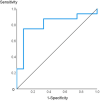Diurnal production of cortisol and prediction of treatment response in rheumatoid arthritis: a 6-month, real-life prospective cohort study
- PMID: 38233075
- PMCID: PMC10806498
- DOI: 10.1136/rmdopen-2023-003575
Diurnal production of cortisol and prediction of treatment response in rheumatoid arthritis: a 6-month, real-life prospective cohort study
Abstract
Objectives: A reduced adrenal reserve-associated cortisol production relative to the enhanced needs of chronic inflammation (disproportion principle) has been observed in rheumatoid arthritis (RA). We examined the possible clinical value of diurnal cortisol measurements in active RA on treatment response prediction.
Methods: Diurnal cortisol production (measured at: 08-12:00/18:00-22:00) was assessed by electrochemiluminescence immunoassay in 28 consecutive patients with moderately/highly active RA, as well as 3 and 6 months after treatment initiation or/escalation. Twenty-eight COVID-19 patients and 28 age-matched healthy individuals (HC) served as controls.
Results: Saliva diurnal cortisol production in patients with RA was similar to that of HC, despite 12-fold higher serum C reactive protein (CRP) levels, and lower than COVID-19 patients (area under the curve: RA: 87.0±37.6 vs COVID-19: 146.7±14.3, p<0.001), having similarly high CRP. Moreover, a disturbed circadian cortisol rhythm at baseline was evident in 15 of 28 of patients with RA vs 4 of 28 and 20 of 28 of HC and COVID-19 patients, respectively. Treatment-induced minimal disease activity (MDA) at 6 months was achieved by 16 of 28 patients. Despite comparable demographics and clinical characteristics at baseline, non-MDA patients had lower baseline morning cortisol and higher adrenocorticotropic hormone (ACTH) levels compared with patients on MDA (cortisol: 10.9±4.0 vs 18.4±8.2 nmol/L, respectively, p=0.005 and ACTH: 4.8±3.3 vs 2.4±0.4 pmol/L, respectively, p=0.047). Baseline morning cortisol <13.9 nmol/L predicted non-MDA at 6 months (75% sensitivity, 92% specificity, p=0.006). Prospective measurements revealed that individualised diurnal cortisol production remained largely unchanged from baseline to 3 and 6 months.
Conclusions: An impaired adrenal reserve is present in patients with RA. Further studies to confirm that assessment of diurnal cortisol production may be useful in guiding treatment decisions and/or predicting treatment response in RA are warranted.
Trial registration number: NCT05671627.
Keywords: Arthritis; Arthritis, Rheumatoid; Glucocorticoids.
© Author(s) (or their employer(s)) 2024. Re-use permitted under CC BY-NC. No commercial re-use. See rights and permissions. Published by BMJ.
Conflict of interest statement
Competing interests: None declared.
Figures


Similar articles
-
Desmopressin and low-dose ACTH test in rheumatoid arthritis.Eur J Endocrinol. 1998 Mar;138(3):294-301. doi: 10.1530/eje.0.1380294. Eur J Endocrinol. 1998. PMID: 9539304 Clinical Trial.
-
Effects of naproxen and sulphasalazine or methotrexate on hypothalamic-pituitary-adrenal axis activity in patients with rheumatoid arthritis.Clin Exp Rheumatol. 2011 Jan-Feb;29(1):35-42. Epub 2011 Feb 23. Clin Exp Rheumatol. 2011. PMID: 21345290
-
Adrenocortical response to low-dose ACTH test in female patients with rheumatoid arthritis.Ann N Y Acad Sci. 2008 Dec;1148:562-6. doi: 10.1196/annals.1410.027. Ann N Y Acad Sci. 2008. PMID: 19120158
-
Adrenocortical dysfunction in rheumatoid arthritis: Α narrative review and future directions.Eur J Clin Invest. 2022 Jan;52(1):e13635. doi: 10.1111/eci.13635. Epub 2021 Jun 13. Eur J Clin Invest. 2022. PMID: 34097322 Review.
-
Circadian rhythms: glucocorticoids and arthritis.Ann N Y Acad Sci. 2006 Jun;1069:289-99. doi: 10.1196/annals.1351.027. Ann N Y Acad Sci. 2006. PMID: 16855156 Review.
Cited by
-
Steroid hormones and influence of therapeutic drugs in Chinese postmenopausal rheumatoid arthritis patients.Front Immunol. 2025 May 12;16:1589798. doi: 10.3389/fimmu.2025.1589798. eCollection 2025. Front Immunol. 2025. PMID: 40421020 Free PMC article.
-
Individual Cortisol Production in Active Rheumatoid Arthritis Associates with Treatment Responses: A Pilot, Two-Year Study.Mediterr J Rheumatol. 2025 May 28;36(2):193-199. doi: 10.31138/mjr.131224.ipc. eCollection 2025 Jun. Mediterr J Rheumatol. 2025. PMID: 40757123 Free PMC article.
-
Increased prevalence of inflammatory arthritis, systemic lupus erythematosus and systemic sclerosis, during 2020-2023 versus 2016-2019 in a Nation-Wide Cohort Study.Rheumatol Int. 2024 Dec;44(12):2837-2846. doi: 10.1007/s00296-024-05733-y. Epub 2024 Oct 8. Rheumatol Int. 2024. PMID: 39375202
-
Prevalence of Various Systemic and Organ-Specific Autoimmune Markers in Addison's Disease Patients Compared to Healthy Controls.J Clin Med. 2025 Jun 3;14(11):3951. doi: 10.3390/jcm14113951. J Clin Med. 2025. PMID: 40507712 Free PMC article.
References
-
- Gudbjörnsson B, Skogseid B, Oberg K, et al. . Intact Adrenocorticotropic hormone secretion but impaired Cortisol response in patients with active rheumatoid arthritis. J Rheumatol 1996;23:596–602. - PubMed
-
- Crofford LJ, Kalogeras KT, Mastorakos G, et al. . Circadian relationships between interleukin (IL)-6 and hypothalamic-pituitary-adrenal axis hormones: failure of IL-6 to cause sustained Hypercortisolism in patients with early untreated rheumatoid arthritis. J Clin Endocrinol Metab 1997;82:1279–83. 10.1210/jcem.82.4.3852 - DOI - PubMed
-
- Gutiérrez MA, García ME, Rodriguez JA, et al. . Hypothalamic-pituitary-adrenal axis function in patients with active rheumatoid arthritis: a controlled study using insulin Hypoglycemia stress test and prolactin stimulation. J Rheumatol 1999;26:277–81. - PubMed
-
- Cutolo M, Foppiani L, Prete C, et al. . Hypothalamic-pituitary-Adrenocortical axis function in premenopausal women with rheumatoid arthritis not treated with glucocorticoids. J Rheumatol 1999;26:282–8. - PubMed
MeSH terms
Substances
Associated data
LinkOut - more resources
Full Text Sources
Medical
Research Materials
Miscellaneous
